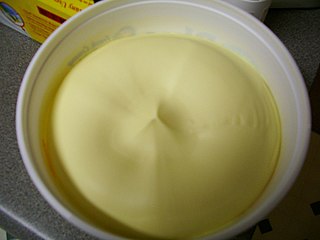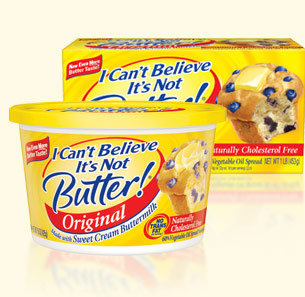
Marmite ( MAR-myte) is a British savoury food spread based on yeast extract, invented by the German scientist Justus von Liebig. It is made from by-products of beer brewing (lees) and is produced by the British company Unilever. Marmite is a vegan source of B vitamins, including supplemental vitamin B12. A traditional method of use is to spread it very thinly on buttered toast.

Vegetable oils, or vegetable fats, are oils extracted from seeds or from other parts of fruits. Like animal fats, vegetable fats are mixtures of triglycerides. Soybean oil, grape seed oil, and cocoa butter are examples of seed oils, or fats from seeds. Olive oil, palm oil, and rice bran oil are examples of fats from other parts of fruits. In common usage, vegetable oil may refer exclusively to vegetable fats which are liquid at room temperature. Vegetable oils are usually edible.

Margarine is a spread used for flavoring, baking, and cooking. It is most often used as a substitute for butter. Although originally made from animal fats, most margarine consumed today is made from vegetable oil. The spread was originally named oleomargarine from Latin for oleum and Greek margarite. The name was later shortened to margarine.

A food pyramid is a representation of the optimal number of servings to be eaten each day from each of the basic food groups. The first pyramid was published in Sweden in 1974. The 1992 pyramid introduced by the United States Department of Agriculture (USDA) was called the "Food Guide Pyramid" or "Eating Right Pyramid". It was updated in 2005 to "MyPyramid", and then it was replaced by "MyPlate" in 2011.

Special K is an American brand of breakfast cereal and meal bars manufactured by Kellogg's. The cereal was introduced to the United States in 1955. It is made primarily from grains such as lightly toasted rice, wheat and barley. Special K used to be marketed primarily as a low-fat cereal that can be eaten to help one lose weight.

The Healthy Eating Pyramid is a nutrition guide developed by the Harvard School of Public Health, suggesting quantities of each food category that a human should eat each day. The healthy eating pyramid is intended to provide a more sound eating guide than the widespread food guide pyramid created by the USDA.

Five Alive is a line of fruit juice blends created by Minute Maid, a subsidiary of The Coca-Cola Company. Both the name and the five colors of the logo refer to the five fruit juices each variety contains.

Reese's Take 5 is a candy bar that was released by The Hershey Company in December 2004. The original name of the candy bar was TAKE5 but common usage among consumers added a space. In June 2019, when the candy bar became part of the Reese's family, the name was officially changed to Reese's Take 5.
Yop, created and marketed by Yoplait, is a yogurt drink sold in supermarkets and convenience stores in Belgium, Canada, France, Ireland, Switzerland, the United Kingdom, and occasionally in the Netherlands, Portugal, Spain and the United States. The Yoplait's Smoothie drink in Sweden and Norway is called Safari.

I Can't Believe It's Not Butter! is a brand of a spreadable emulsion of vegetable oil in water with butter flavor produced by Upfield and marketed as a substitute for butter.

The nutrition facts label is a label required on most packaged food in many countries, showing what nutrients and other ingredients are in the food. Labels are usually based on official nutritional rating systems. Most countries also release overall nutrition guides for general educational purposes. In some cases, the guides are based on different dietary targets for various nutrients than the labels on specific foods.
Almond butter is a food paste made from grinding almonds into a nut butter. Almond butter may be "crunchy" or "smooth", and is generally "stir" or "no-stir" (emulsified). Almond butter may be either raw or roasted, but this describes the almonds themselves, prior to grinding.

Strained yogurt, Greek yogurt, yogurt cheese, sack yogurt, or kerned yogurt is yogurt that has been strained to remove most of its whey, resulting in a thicker consistency than normal unstrained yogurt, while still preserving the distinctive sour taste of yogurt. Like many types, strained yogurt is often made from milk enriched by boiling off some water content, or by adding extra butterfat and powdered milk. In Europe and North America, it is often made from low-fat or fat-free cow's milk. In Iceland, a similar product named skyr is made.
Canadian health claims by Health Canada, the department of the Government of Canada responsible for national health, has allowed five scientifically verified disease risk reduction claims to be used on food labels and on food advertising. Other countries, including the United States and Great Britain, have approved similar health claims on food labels.
The history of USDA nutrition guidelines includes over 100 years of nutrition advice promulgated by the USDA. The guidelines have been updated over time, to adopt new scientific findings and new public health marketing techniques. The current guidelines are the Dietary Guidelines for Americans 2015–2020. been criticized as not accurately representing scientific information about optimal nutrition, and as being overly influenced by the agricultural industries the USDA promotes.

Steam minced pork refers to a savory dish popular in Hong Kong and the Guangdong area of China. Consisting mainly of minced pork, it typically includes ingredients such as dried squid (土魷) and preserved cabbage (梅菜). The dish is cooked by steaming over a pot of boiling water until it is well cooked. The seasonings usually include soy sauce, salt, sugar and corn flour and occasionally white pepper and sesame oil. It is usually served with rice during lunch or dinner.

Vegan cheese is a category of non-dairy, plant-based cheese analogues. Vegan cheeses range from soft fresh cheeses to aged and cultured hard grateable cheeses like plant-based Parmesan. The defining characteristic of vegan cheese is the exclusion of all animal products.

Máchica is a type of flour made from ground toasted barley or other toasted grains. It is used in Bolivian, Ecuadorian and Peruvian cuisine.
Upfield Holdings B.V. is a Dutch food company owning multiple brands of margarine, food spreads, and plant-based foods, including Flora and Blue Band. It states that it is the largest plant-based consumer packaged goods company in the world, operating in 95 countries.